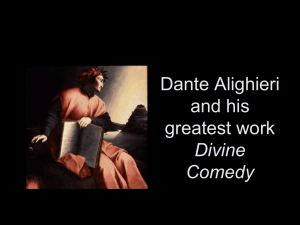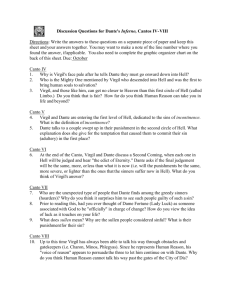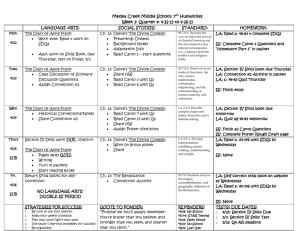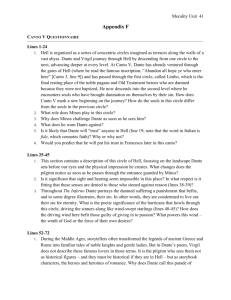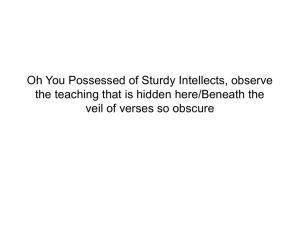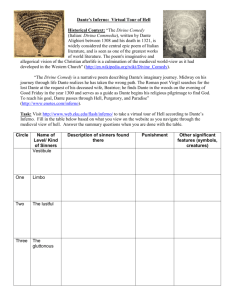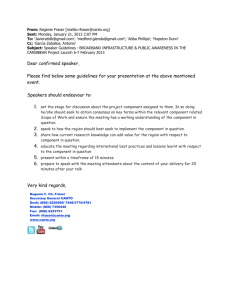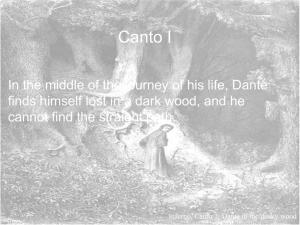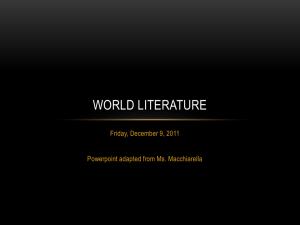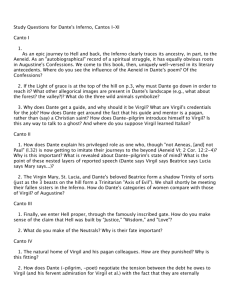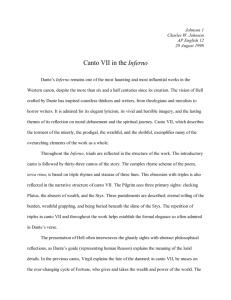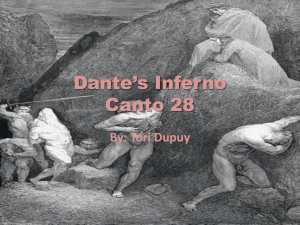Introduction to Dante Lecture Notes Page
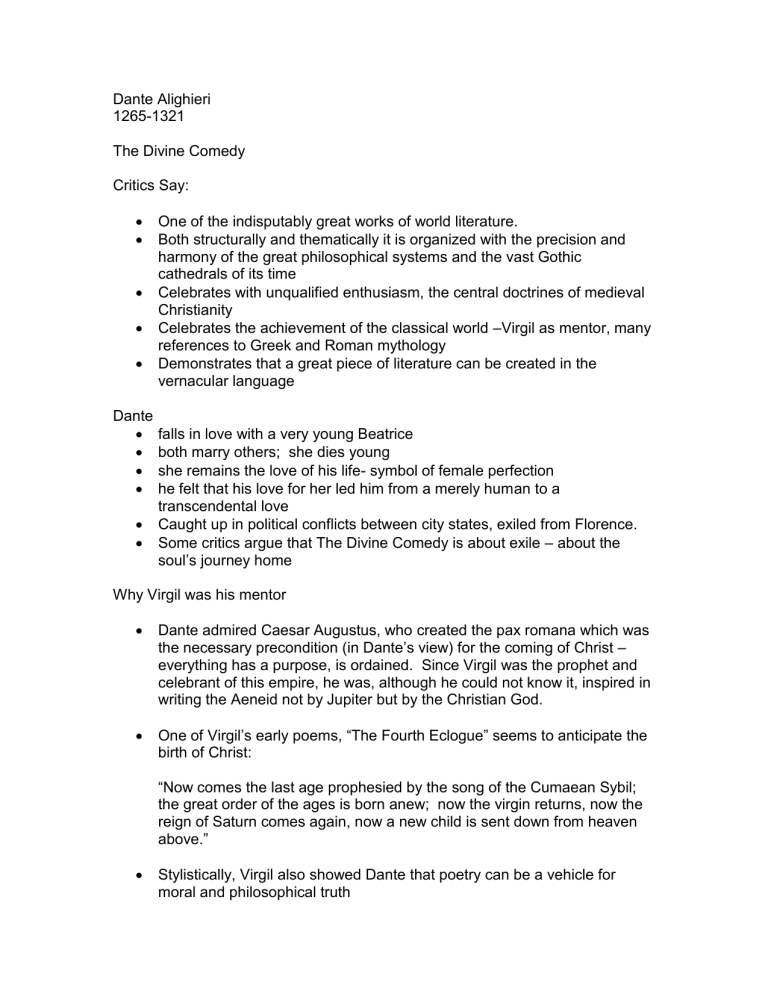
Dante Alighieri
1265-1321
The Divine Comedy
Critics Say:
One of the indisputably great works of world literature.
Both structurally and thematically it is organized with the precision and harmony of the great philosophical systems and the vast Gothic cathedrals of its time
Celebrates with unqualified enthusiasm, the central doctrines of medieval
Christianity
Celebrates the achievement of the classical world
–Virgil as mentor, many references to Greek and Roman mythology
Demonstrates that a great piece of literature can be created in the vernacular language
Dante
falls in love with a very young Beatrice
both marry others; she dies young
she remains the love of his life- symbol of female perfection
he felt that his love for her led him from a merely human to a transcendental love
Caught up in political conflicts between city states, exiled from Florence.
Some critics argue that The Divine Comedy is about exile
– about the soul’s journey home
Why Virgil was his mentor
Dante admired Caesar Augustus, who created the pax romana which was the necessary precondition (in Dante’s view) for the coming of Christ – everything has a purpose, is ordained. Since Virgil was the prophet and celebrant of this empire, he was, although he could not know it, inspired in writing the Aeneid not by Jupiter but by the Christian God.
One of Virgil’s early poems, “The Fourth Eclogue” seems to anticipate the birth of Christ:
“Now comes the last age prophesied by the song of the Cumaean Sybil; the great order of the ages is born anew; now the virgin returns, now the reign of Saturn comes again, now a new child is sent down from heaven above.”
Stylistically, Virgil also showed Dante that poetry can be a vehicle for moral and philosophical truth
Dante’s Style in the Divine Comedy
Medieval definition of a comedy
Narrative structure: tragedy beings in happiness, ends in misery, a comedy the reverse
Style: tragedy is serious, formal; comedy can have a range of styles
Character: tragedy deals with important historical characters; comedy can
include commoners
Subject Matter: tragedy deals with events of great significance; comedy
with every day events
Allegory: a story with a symbolic level of meaning
Medieval writers and poets loved allegory
– represented their belief that
God’s purpose could be discovered in every action
Here Dante represents the human soul progressing in its knowledge and understanding of God’s love
“Il olce stil nuovo” – the sweet new style wrote in the ordinary language of the people, perfected techniques of versification celebrated women as the symbol of perfection
Unity and order everywhere.
Three parts to The Divine Comedy: embodies the Holy Trinity
34, 33, 33 cantos in each canticle
Written in terza rima (three line rhyme). ).
9 circles In Hell; 9 terraces in Purgatory
In Hell, the lost souls are arranged in three main groups, occupy nine circles
Each canticle ends with stars (visible signs of God’s oversight
Ethical Pattern
The natural inclination of every human being is love, a movement to something outside the self.
The natural and proper object of love is God.
Sin occurs when love is directed to the wrong object.
All three places organized according to degree of misplacing or realizing love of God (1830)
Autobiographical and Philosophical
Dante’s love for Beatrice helps him overcome his own spiritual crisis
Love for her leads him on his allegorical quest towards God and the reaffirmation of his faith
In order to know God, he has to experience Hell (The Inferno), Pergatory and Paradise.
Virgil, his mentor, represents the best of human reason, can only lead him so far
All levels contain concrete examples of degrees of sinners and saints from
Dante’s own times, from mythology, from history
Dante uses his framework to criticize abuses within the government, the church and personal enemies.
Purpose of the Divine Comedy
To assist in the spiritual development of the reader, to teach a moral and spiritual lesson about “right” behavior, and the consequences of “wrong” behavior
The Inferno
Hell is a huge funnel extending into the center of the earh
One’s punishment in hell is not merely appropriate to the crime, but is the crime.
In the Inferno every sinner commits his sin forever, for all of eternity: and it is this endless act of sinning that is the punishment.
Examples of sins punished in Hell: the lower in hell, the worse the sin
Date of journey: Good Friday, 1300- trip through Hell follows Christ’s descent to
Hell on Good Friday and his rising on Easter Sunday morning
Dante tries to climb Mount Purgatory, but faces the sins that prevent man from reaching salvation: pride, envy, greed, represented by 3 beasts: the leopard, the lion and the wolf
Virgil appears, sent by Mary through Beatrice, to rescue Dante
Limbo, the pagan paradise (canto 4);
Carnal Love (canto 5) Francesca and Paolo , now blown by the wind;
gluttons, now eating mud and excrement (canto 6)
greed and wastefulness (canto 7);
heretics (canto 9-10), now buried in flaming tombs;
suicides, now turned into dead trees (13);
simonists clergy who sold their divine offices for money (canto 19) now buried upside down in flaming tombs;
political grafters , who sold political office for money (canto 21), now enmired in boiling pitch with demons poking their heads down
hypocrites (canto 23) in monastic cloaks and hoods of lead, brilliantly decorated on the surface
thieves (canto 24) particularly popes
betrayers of their family, their country, their guests; buried in ice in the ninth circle (canto 32-33)
canto 34: Satan, buried in ice - bat-like wings with three mouths: red face of hate, right face of impotence, left face of ignorance – tortured traitors hang from the mouths: Judas- betrayed Jesus; Brutus and
Cassius betrayed Julius Caesar,
